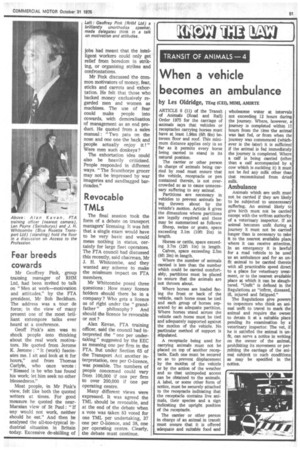When a vehicle becomes an ambulance
Page 53

If you've noticed an error in this article please click here to report it so we can fix it.
by Les Oldridge, TEng (CEI), MIMI, AMIRTE ARTICLE 6 (11) of the Transit of Animals (Road and Ram Order 1975 for the carriage of animals says that vehicles or receptacles carrying horses must have at least 1.98m (6ft Bin) between floor and roof. This Minimum distance applies only in so far as it permits every horse being carried to 'stand in its natural position.
The carrier or other person in charge of animals being car ried by road must ensure that the vehicle, receptacle or pen contained therein, is not overcrowded so as to cause unnecessary suffering to any animal.
Partitions are necessary in vehicles to prevent animals be ing thrown about 'by the vehicle's motion. Article 8 gives the dimension's where partitions are legally required and these may be summarised as follows: Sheep, swine or goats, space exceeding 3.1m (loft 2in) in length.
Horses or cattle, space exceeding 3.7m (12ft Fin) in length.
Calves, space exceeding 2.5m (8ft 2in) in length.
Where the number of animals carried is less than the number which could be carried icomfortably, partitions must be placed to ensure that the animals are not thrown about.
Where horses are loaded facing the front or back of the vehicle, each horse must be tied and each group of horses separated by an adequate partition.
Where horses -stand across the vehicle each horse must be tied and adequately supported against the motion of the vehicle. No particular method of support is Stipulated.
A receptacle being used for carrying animals must not be placed on top of another recep tacle. Each one must be secured so as to prevent displacement by the .motion of the vehicle or by the action of the weather and so that unimpeded access can be obtained to the animals.
A label, or some other form of notice, must be securely attached to the receptacle indicating that the receptacle contains live animals, their species and a sign indicating the upright position Of the receptacle.
The carrier or other person in charge of an animal in transit must ensure that it is offered adequate and suitable food and Wholesome water at intervals not exceeding 12 hours during the journey. Where, however, a journey is completed Within 15 hours from the time the animal was levet fed, or from when the journey was commenced (whichever is the latier) it is sufficient if the animal is fed immediately the journey is completed. Where a calf is being carried (Other than a calf accompanied by A cow which is suckling it) it must not he fed any milk other than that reconstituted from dried
Ambulance
Animals which are unfit must not be carried if they are likely to he .subjected to unnecessari suffering. An animal likely to give birth must not be carried except With the written authority of a veterinary inspector. If an animal becomes unfit during a. journey it must not be carried longer than is necessary to take it to the nearest available place where it can receive attention. In an ernergency it is lawful for a road vehicle to be used as an ambulance and for an
un
fit animal to be carried therein with all practicable speed direct to a place for veterinary treatment, or to the nearest available place art which it can be slaughtered. "Unfit" is defined in the Regulations as "infirm, diseased, na, injured and fatigued."
The Regulations give powers to inspectors Who think an anima/ unfit to travel to mark the animal and require the owner to detain it at a suitable place pending its examination by a veterinary inspeCtor. The vet, if he is satisfied the animal is unfit, can serve a nOtice in writing on the owner of the animal, prohibiting its movement or permitting the carriage of the animal subjeCt to such conditions as may be specified in the notice.
































































































